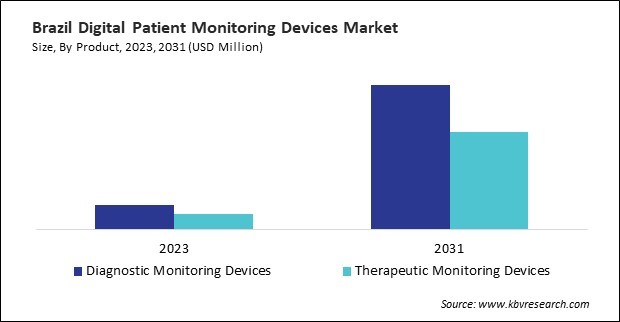The Latin America, Middle East and Africa Digital Patient Monitoring Devices Market would witness market growth of 27.7% CAGR during the forecast period (2024-2031).
The Brazil market dominated the LAMEA Digital Patient Monitoring Devices Market by Country in 2023, and would continue to be a dominant market till 2031; thereby, achieving a market value of $17,762.7 million by 2031. The Argentina market is registering a CAGR of 28.7% during (2024 - 2031). Additionally, The UAE market would witness a CAGR of 27.3% during (2024 - 2031).

The rapid growth of mobile health applications and advancements in wireless connectivity, such as 5G, drive significant changes in the digital patient monitoring devices market. Mobile health apps now allow users to manage and track health metrics directly from their smartphones or tablets, making health monitoring more accessible and user-friendly. This shift empowers patients to actively participate in their health, as they can monitor conditions in real-time. By integrating health tracking into daily life, these applications support a more data-driven approach to healthcare, enhancing patient engagement as well as adherence to treatment plans.
Wireless connectivity, especially 5G, has also enhanced the speed and reliability of data transfer, enabling seamless and immediate communication between patient monitoring devices and healthcare providers. This connectivity is essential for real-time interventions, allowing providers to respond quickly to any critical changes in a patient’s health. It also expands healthcare accessibility for those in remote or underserved areas, allowing them to receive continuous care without frequent visits to medical facilities. Mobile health applications and wireless technology are making healthcare more personalized, responsive, and widely accessible, reshaping the digital monitoring landscape and supporting a proactive approach to health management.
Governments across the LAMEA region increasingly prioritize digital health and preventive measures to combat lifestyle diseases. Brazil’s Strategic Action Plan for Tackling Noncommunicable Diseases promotes preventive health and encourages the use of digital tools for managing obesity, hypertension, and other chronic conditions. Saudi Arabia’s Vision 2030 also focuses on healthcare digitalization, with special attention to lifestyle diseases like diabetes. In South Africa, the National Health Insurance (NHI) program aims to enhance healthcare accessibility, indirectly supporting the adoption of digital health tools, especially in remote areas.
The UAE Vision 2021 emphasizes technology integration in healthcare to improve outcomes, with campaigns for managing diabetes and obesity. Similarly, Argentina’s National Program for Healthy Eating and Prevention of Obesity raises public awareness about chronic disease prevention, supporting digital health tools. These regional initiatives underscore LAMEA’s commitment to digital health as a key strategy for managing and preventing lifestyle diseases, marking it as a diverse and evolving market for digital patient monitoring devices.
Free Valuable Insights: The Worldwide Digital Patient Monitoring Devices Market is Projected to reach USD 815.1 Billion by 2031, at a CAGR of 24.9%
Based on Product, the market is segmented into Diagnostic Monitoring Devices (Vital Sign Monitors, Sleep Monitors, Fetal Monitors, and Neuromonitors & Other Monitors) and Therapeutic Monitoring Devices (Insulin Monitors, Respiratory Monitors and Other Monitors). Based on Type, the market is segmented into Wearable Devices, Wireless Sensor Technology, mHealth, Telehealth, and Remote Patient Monitoring (Hospital Inpatient, Ambulatory Patient, and Smart Home Healthcare). Based on countries, the market is segmented into Brazil, Argentina, UAE, Saudi Arabia, South Africa, Nigeria, and Rest of LAMEA.
By Product
By Type
By Country
Our team of dedicated experts can provide you with attractive expansion opportunities for your business.

